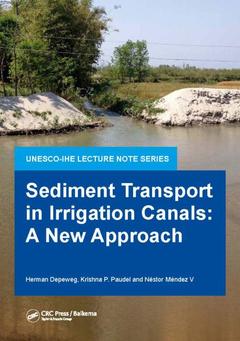Sediment Transport in Irrigation Canals A New Approach IHE Delft Lecture Note Series
Auteur : Depeweg Herman

Sediment transport in irrigation canals influences to a great extent the sustainability of an irrigation system. Unwanted erosion or deposition will not only increase maintenance costs, but may also lead to unfair, unreliable and unequitable distribution of irrigation water to the end users. Proper knowledge of the characteristics, including behaviour and transport of sediment will help to design irrigation systems, plan efficient and reliable water delivery schedules, to have a controlled deposition of sediments, to estimate and arrange maintenance activities, etc. The main aim of these lecture notes is to present a detailed analysis and physical and mathematical descriptions of sediment transport in irrigation canals and to describe the mathematical model SETRIC that predicts the sediment transport, deposition and entrainment rate as function of time and place for various flow conditions and sediment inputs. The model is typically suited for the simulation of sediment transport under the particular conditions of non-wide irrigation canals where the flow and sediment transport are strongly determined by the operation of the flow control structures. The lecture notes will contribute to an improved understanding of the behaviour of sediments in irrigation canals. They will also help to decide on the appropriate design of the system, the water delivery plans, to evaluate design alternatives and to achieve an adequate and reliable water supply to the farmers.
Date de parution : 10-2014
17.4x24.6 cm
Date de parution : 06-2018
17.3x24.7 cm
Thèmes de Sediment Transport in Irrigation Canals :
Mots-clés :
bed; load; capacity; deposition; water; depth; downstream; level; season; concentration; Sediment Transport; Irrigation Canal; Sediment Transport Capacity; Irrigation Season; Flow Control Structures; Downstream Water Level; Sediment Concentration; Bed Load; Downstream Control; Total Sediment Transport; Weed Factor; Incoming Sediment Load; Canal Reach; Actual Water Depth; Side Slope; Composite Roughness; Bed Forms; Upstream Water Level; Sediment Transport Predictors; Incoming Sediment; Equivalent Roughness; Broad Crested Weir; Sediment Deposition; Design Discharge; Tractive Force Method



